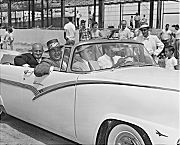| Entries |
| D |
|
Daley's Chicago
|

|
Mayor Daley enjoyed great success, particularly in his early years, in reshaping Chicago's landscape. He presided over an unprecedented building boom that created a spectacular downtown skyline, completed the city's expressway network, enlarged Chicago- O'Hare International Airport, and constructed the University of Illinois at Chicago –Chicago Circle. His attention to prompt and efficient service delivery made Chicago famous as “the city that works,” and, by the 1970s, when the nation's metropolises were experiencing financial crises, his success at keeping Chicago solvent earned him a reputation as a fiscal genius. Based in part on his legendary machinations on behalf of John F. Kennedy in the 1960 presidential election, Daley became a powerful force in the national Democratic Party and a leading spokesman for urban interests in the 1960s and 1970s.
Despite Daley's continued electoral triumphs and many achievements, his forceful leadership often produced heated controversy. His autocratic manner was more efficient than democratic. The brutal suppression of dissent at the 1968 Democratic National Convention tarnished the city's image, as did his infamous “shoot-to-kill” order shortly after the rioting following the assassination of Martin Luther King, Jr. As Chicago's nonwhite population increased dramatically, Daley enjoyed little success mitigating the escalating racial tensions and aligned himself with conservative whites against civil rights groups. He resisted residential desegregation, refused to implement affirmative action procedures in the city's police department, defended the public schools' racially exclusionary policies, and used urban renewal funds to erect massive public housing projects that kept black Chicagoans within existing ghettos. Residents of white as well as black neighborhoods questioned Daley's decision to protect the city against suburban decentralization by revitalizing the Loop and North Michigan Avenue. His death and the subsequent dissolution of the Democratic machine unleashed forces of change long held in check, resulting in the election of Chicago's first black mayor, Harold Washington, in 1983.
The Encyclopedia of Chicago © 2004 The Newberry Library. All Rights Reserved. Portions are copyrighted by other institutions and individuals. Additional information on copyright and permissions.